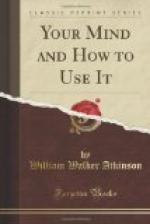After recognition of the problem, our next step is to start vigorous efforts to solve it. In doing this, we cast about for means; we summon all the powers at our disposal. In the case of the automobile, we call to mind other accidents and the causes of them; we remember that once the spark-plug played out, so we test this hypothesis. At another time some dust got into the carburetor, so we test this. So we go on, calling up possible causes and applying appropriate remedies until the right one is found and the engine is started. In bringing to bear upon the problem facts from our past experience, we form a series of judgments. In the case of the problem as to what college to attend, we might form these judgments: this college is nearer home; that one has a celebrated faculty; this one has good laboratories; that one is my father’s alma mater. So we might go on, bringing up all the facts regarding the problem and fitting each one mentally to see how it works. Note that this utilization of ideas should not consist merely of fumbling about in a vague hope of hitting upon some solution. It must be a systematic search, guided by carefully chosen ideas. For example, “if the clock on the mantle-piece has stopped, and we have no idea how to make it go again, but mildly shake it in the hope that something will happen to set it going, we are merely fumbling. But if, on moving the clock gently so as to set the pendulum in motion, we hear it wobbling about irregularly, and at the same time observe that there is no ticking of any kind, we come to the conclusion that the pendulum has somehow or other escaped the little catch that connects it with the mechanism, we have been really thinking. From the fact that the pendulum wobbles irregularly, we infer that it has lost its proper catch. From the fact that there is no ticking, we infer the same thing, for even when there is something wrong with the clock that will prevent it from going permanently, if the pendulum is set in motion by force from without it will tick for a few seconds before it comes to rest again. The important point to observe is that there must be inference. This is always indicated by the word therefore or its equivalent. If you reach a conclusion without having to use or at any rate to imply a therefore, you may take it for granted that you have not been really thinking, but only jumping to conclusions.”
This process of putting facts in the form of judgments and drawing inferences, may be likened to a court-room scene where arguments are presented to the judge. As each bit of evidence is submitted, it is subjected to the test of its applicability to the situation or to similar situations in the past. It is rigidly examined and nothing is accepted as a candidate for the solution until it is found by trial (of course, in imagination) to be pertinent to the situation.




